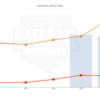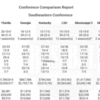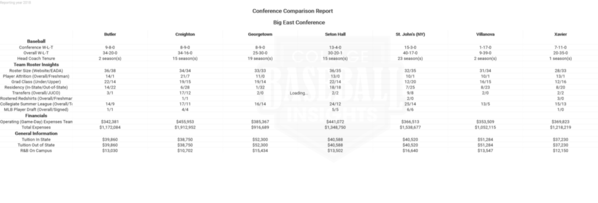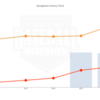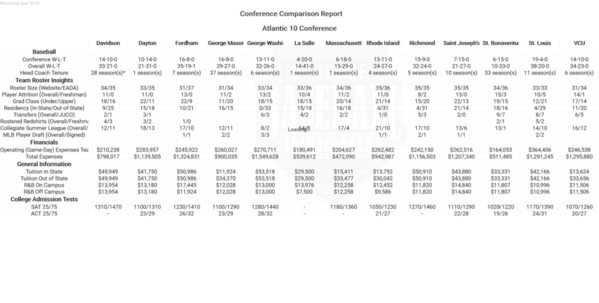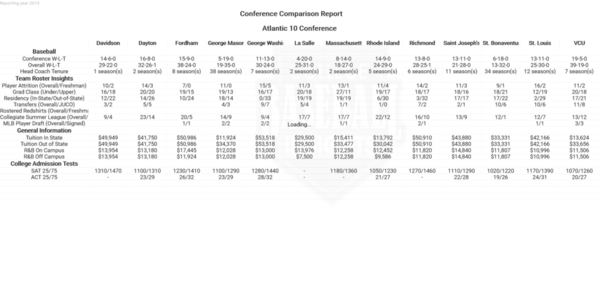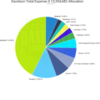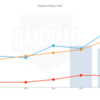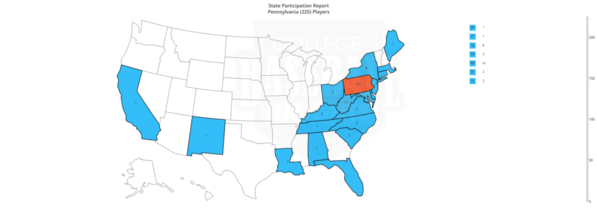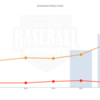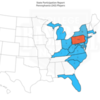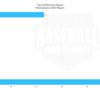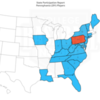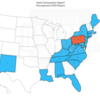Is there a listing of how many baseball scholarships are offered by each D1 program?
For example, Vanderbilt=11.7, Davidson=3.0, Columbia=0.0, other programs = ??
Replies sorted oldest to newest
I asked recently for some research I wanted to do. The general response was it’s not readily available.
Plus, sometimes programs that are fully funded have money comes from "other coffers" (donations?), that may not show up on some lists? It is a hard thing to find and never has a full list been published on this site. If you have a question about a particular program, folks may know.
Also, doesn't in state/out of state affect it? Beyond number of scholarships, schools still have budgets.
nycdad posted:Also, doesn't in state/out of state affect it? Beyond number of scholarships, schools still have budgets.
Yes. A school may only have 100k in scholarship money. But that can easily provide 10 full scholarships for some schools. Public schools from baseball rich areas are golden. That is why you see so many in state kids at a lot of these schools and in many cases students from bordering states that qualify for tuition waivers based on GPA/scores. A lot of the big $ is going to out of state studs.
It is very easy to keep the top local talent home when the school only costs 9k a year to begin with. Part of the reason the SEC/ACC dominates. Great local talent, beautiful facilities, and cheap tuition. Can't beat it.
The Equity in Athletics Disclosure Act requires co-educational institutions of postsecondary education that participate in a Title IV, federal student financial assistance program, and have an intercollegiate athletic program, to prepare an annual report to the Department of Education on athletic participation, staffing, and revenues and expenses, by men's and women's teams. The Department will use this information in preparing its required report to the Congress on gender equity in intercollegiate athletics.
Those schools that are required to report EADA use the following worksheet to capture student aid by team, but the schools report said data at the school level.
In my humble opinion, the process is similar to purchasing a car, you will not get the exact numbers but there are other insights that can assist you in understanding if a school is investing in the baseball program
How are the finances allocated by sport
What is the 5 or 10 year trend. Look at Total Expenses (orange line), Operating Expense (red line).
Compare the Total Expenses within the conference
Regards
Attachments
My son talked to Georgetown and they told him they had 6 fully funded ships for 2019 but hoped they would get 8 starting in 2020.
Nonamedad posted:My son talked to Georgetown and they told him they had 6 fully funded ships for 2019 but hoped they would get 8 starting in 2020.
Attachments
Patter40 posted:Is there a listing of how many baseball scholarships are offered by each D1 program?
For example, Vanderbilt=11.7, Davidson=3.0, Columbia=0.0, other programs = ??
Davidson has 7.0: https://www.davidson.edu/news/...rm-davidson-baseball
They didn't publish a list but the ABCA did put out some stats detailing that half the programs have the maximum 11.7 and the other half average about 9.5 scholarships (bringing the overall average down to 10.58).
https://d1baseball.com/news/ab...mer-2019-hot-topics/
Excerpts:
"First, some data provided by the ABCA:
Total Division I baseball programs in 2018: 297
Limit of scholarship equivalencies: 11.7
Number of programs offering 11.7 scholarships: 149 (50 percent)
Average number of equivalencies awarded: 10.58
Average number of student-athletes receiving aid: 24 (out of a maximum 27)"
2019Dad posted:Patter40 posted:Is there a listing of how many baseball scholarships are offered by each D1 program?
For example, Vanderbilt=11.7, Davidson=3.0, Columbia=0.0, other programs = ??Davidson has 7.0: https://www.davidson.edu/news/...rm-davidson-baseball
They didn't publish a list but the ABCA did put out some stats detailing that half the programs have the maximum 11.7 and the other half average about 9.5 scholarships (bringing the overall average down to 10.58).
https://d1baseball.com/news/ab...mer-2019-hot-topics/
Excerpts:
"First, some data provided by the ABCA:
Total Division I baseball programs in 2018: 297
Limit of scholarship equivalencies: 11.7
Number of programs offering 11.7 scholarships: 149 (50 percent)
Average number of equivalencies awarded: 10.58
Average number of student-athletes receiving aid: 24 (out of a maximum 27)"
Scholarships are one financial component that a student-athlete should review when targeting a school.
It is also important to review the overall financial health of the target school.
If you are looking into investing in any business, organization, etc., it is important to review their budget.
EADA Total Expenses is a Key Performance Indicator that one should review to understand how a team is trending.
Total Expenses Include:
This includes appearance guarantees and options, athletically related student aid, contract services, equipment, fundraising activities, operating expenses, promotional activities, recruiting expenses, salaries and benefits, supplies, travel, and any other expenses attributable to intercollegiate athletic activities.
What is the budget allocation by sport?
Important to know, those revenue generating sports feed the beast.
Attachments
Nonamedad posted:My son talked to Georgetown and they told him they had 6 fully funded ships for 2019 but hoped they would get 8 starting in 2020.
Sorry, but this made me giggle! Gtown has been saying this for at least 10 years.
Jesuits lol.
fenwaysouth posted:Nonamedad posted:My son talked to Georgetown and they told him they had 6 fully funded ships for 2019 but hoped they would get 8 starting in 2020.
Sorry, but this made me giggle! Gtown has been saying this for at least 10 years.
Good one. Follow the $$$
CollegebaseballInsights posted:Scholarships are one financial component that a student-athlete should review when targeting a school.
It is also important to review the overall financial health of the target school.
If you are looking into investing in any business, organization, etc., it is important to review their budget.
EADA Total Expenses is a Key Performance Indicator that one should review to understand how a team is trending.
Honestly, choosing a school that is a good fit is hard enough to begin with. Most of the schools are only giving a week or two to decide. 14-18 year olds should not be worrying about the financial health of the school. That is what ADs, presidents, and the board of trustees are for. Big budget, small budget, none of it matters. They show you the facilities and give you a pitch on why you should play for them. They tell you what equipment you get and go thru some majors and that is it. As far as budget, endowment, and everything else - that is out of the control of the player and even the coaches.
PABaseball posted:CollegebaseballInsights posted:Scholarships are one financial component that a student-athlete should review when targeting a school.
It is also important to review the overall financial health of the target school.
If you are looking into investing in any business, organization, etc., it is important to review their budget.
EADA Total Expenses is a Key Performance Indicator that one should review to understand how a team is trending.
Honestly, choosing a school that is a good fit is hard enough to begin with. Most of the schools are only giving a week or two to decide. 14-18 year olds should not be worrying about the financial health of the school. That is what ADs, presidents, and the board of trustees are for. Big budget, small budget, none of it matters. They show you the facilities and give you a pitch on why you should play for them. They tell you what equipment you get and go thru some majors and that is it. As far as budget, endowment, and everything else - that is out of the control of the player and even the coaches.
My son went to a school that wasn't a good fit. He got injured his freshman year, SLAP tear. Hard to return. Note throughout HS, son worked out with HOF Trainer, never hurt always prepared for the season. Financials review show investment (training facility, staff, etc.). It is always about the $$$. Check out the numbers of the power 5 conferences. Members that he played with at 13u and 14u level that are now MLB, Devin Smeltzer, Zac Gallen, Matt Thasis others are in the system (Josh Ockimey, Tyler Philips, Joe Gatto, etc) just to name a few.
Otherwise where do you think the scholarship dollars are sourced. They might take some $$$ back year 2 or 3.
PABaseball posted:CollegebaseballInsights posted:Scholarships are one financial component that a student-athlete should review when targeting a school.
It is also important to review the overall financial health of the target school.
If you are looking into investing in any business, organization, etc., it is important to review their budget.
EADA Total Expenses is a Key Performance Indicator that one should review to understand how a team is trending.
Honestly, choosing a school that is a good fit is hard enough to begin with. Most of the schools are only giving a week or two to decide. 14-18 year olds should not be worrying about the financial health of the school. That is what ADs, presidents, and the board of trustees are for. Big budget, small budget, none of it matters. They show you the facilities and give you a pitch on why you should play for them. They tell you what equipment you get and go thru some majors and that is it. As far as budget, endowment, and everything else - that is out of the control of the player and even the coaches.
Correction. Financial health of sports programs. E.g Temple(2014), Akron (2015), Winston-Salem (2019). Remember scholarships are $$$.
CollegebaseballInsights posted:My son went to a school that wasn't a good fit. He got injured his freshman year, SLAP tear. Hard to return. Note throughout HS, son worked out with HOF Trainer, never hurt always prepared for the season. Financials review show investment (training facility, staff, etc.). It is always about the $$$. Check out the numbers of the power 5 conferences. Members that he played with at 13u and 14u level that are now MLB, Devin Smeltzer, Zac Gallen, Matt Thasis others are in the system (Josh Ockimey, Tyler Philips, Joe Gatto, etc) just to name a few.
Otherwise where do you think the scholarship dollars are sourced. They might take some $$$ back year 2 or 3.
I'm still not sure what you mean or what former teammates have to do with anything. You're doing good work with all the data, and I think it's useful, but I'm not sure what you're getting at. Facilities are already there or in the works. Staff is already hired. Even with the financial allotment, you have no idea how much of that is going towards travel, recruitment, meals, apparel, etc. All that is for the coach to worry about. What the players need to worry about is education, coaches, conference, etc.
Maybe your sons injury was inevitable. Maybe it was from the way he was doing things in the past and it finally tore when he got to college. Maybe it had to do with growth, lifting, stress, etc. It's very possible that the college coaches were incompetents as well. But if you took that staff and put them at a P5 school with a bigger budget you can still end up with the same result.
PABaseball posted:CollegebaseballInsights posted:My son went to a school that wasn't a good fit. He got injured his freshman year, SLAP tear. Hard to return. Note throughout HS, son worked out with HOF Trainer, never hurt always prepared for the season. Financials review show investment (training facility, staff, etc.). It is always about the $$$. Check out the numbers of the power 5 conferences. Members that he played with at 13u and 14u level that are now MLB, Devin Smeltzer, Zac Gallen, Matt Thasis others are in the system (Josh Ockimey, Tyler Philips, Joe Gatto, etc) just to name a few.
Otherwise where do you think the scholarship dollars are sourced. They might take some $$$ back year 2 or 3.
I'm still not sure what you mean or what former teammates have to do with anything. You're doing good work with all the data, and I think it's useful, but I'm not sure what you're getting at. Facilities are already there or in the works. Staff is already hired. Even with the financial allotment, you have no idea how much of that is going towards travel, recruitment, meals, apparel, etc. All that is for the coach to worry about. What the players need to worry about is education, coaches, conference, etc.
Maybe your sons injury was inevitable. Maybe it was from the way he was doing things in the past and it finally tore when he got to college. Maybe it had to do with growth, lifting, stress, etc. It's very possible that the college coaches were incompetents as well. But if you took that staff and put them at a P5 school with a bigger budget you can still end up with the same result.
PABaseball,
I couple of points, the training was wrong for pitching:
Two pitchers needed labrum surgery. Previous year, pitcher required Tommy John. The exercises they were doing were good for football players (bulking up) vs flexibility. Bulking up especially in the hips and shoulders causing you to change your mechanics. Pitching is about internal/external hip rotation, providing early season testing from a Physical Trainer perspective, provides an understanding what a particular player needs in order to stay healthy.
E.g potentially use SOMAX machine, which is used by golfers.
Note, each player is physical different and has different percentage of internal/external flexibility. Each player should have his own unique workout and should be retested every 2 to 3 weeks before the start of the season. During the season, the pitcher should be tested to insure flexibility is within a certain tolerance level, otherwise pitcher will overcompensate, thus leading to bad mechanics. Bad mechanics leads to unnecessary stress on arm.
For pitchers, there are different perspectives, doing squats with weights on shoulders is not beneficial, there are other exercises that you can do for the lower half.
Note, the trainers were not at the level of the personal trainer that we had since 8th grade which included gradual buildup to start the season. So it is important for parent and student/athlete to ask questions and understand their training philosophy, as for the cost of surgery is your responsibility, schools might cover expenses for catastrophic injury. When you see a revolving door at the hospital for baseball related surgery, then there is a issue.
"Staff is already hired. Even with the financial allotment, you have no idea how much of that is going towards travel, recruitment, meals, apparel, etc. All that is for the coach to worry about. What the players need to worry about is education, coaches, conference, etc. "
With respects to coaches (including trainers), should you know the background of the coaches and trainers prior to accepting an offer or should you go in blind and hope for the best?
With respects to financials, colleges must report
Operating (Game-Day) Expenses Per Participant and Operating (Game-Day) Expenses Team provides a glimpse into Lodging, meals, transportation, uniforms, and equipment for coaches, team members, support staff.
Note, will you know everything no, but you can see patterns:
For example, Grossmont College finances increased significantly in 2017 and then significantly decreased in 2018.
Former Asst Athletic Director says Grossmont College cheated to win state championship
With respects to recruitment expenses, how important are the recruiting expenses?
Note, schools are required to report a top level numbers for men and women for all sports.
Instead, what might be more valuable is where a school gets their players from? E.g, a school normally goes fishing in the same watering hole. Every once in a while, they might venture further out in the ocean. In my humble opinion, looking at a 3 to 4 years team rosters will provide some insight as to where a school goes to fish.
Is it perfect, no, there are some other variables.
With respects to "etc", I would respectfully ask, what is "etc"?
On another note, In my humble opinion, student-athletes and parents should also understand where players from their state normally go, thus saving some cost going to showcases, camps and tournaments. Looking back, I wasted a lot of $$$ traveling up and down the Northeast to areas that don't recruit players from the north. Note, fortunately I had a relative in Georgia, so the week long Perfect Game tournament, most of my cost was travel.
Playing against the Japanese in Michigan, although nice, was a $1,500 pile dump.
At the 10k foot level, below is where Freshman Right Handed Pitchers have gone from the state of PA.
2019
What division they compete?
What conference?
2018
2017
Note, with any situation, you will not know every detail, but based on some analysis, you will find patterns. Or ask the appropriate questions to determine if the school is the right fit or make more informed decisions.
E.g. is a school a build vs buy (Juco)
E.G Since moving from D2 to D1 Abliene Christian has recruited most of their players from the JUCO circuit
In 2019, 27 of the 36 players came from JUCOs.
Anyway, great conversation, it is good to get other perspectives.
PM me. More insights to come. It would be good to get your perspective. Note, the objective is to provide more transparency to the stakeholders (student-athlete and parents)
Regards.




